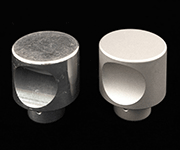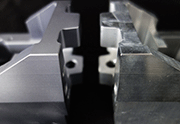E-Archive
Good Vibrations
in Vol. 15 - September Issue - Year 2014
Perfect Finish for Aluminum Surfaces

Aluminum fittings - vibratory finishing + shot blasting + anodization

Aluminum wheel - grinding + smoothing + polishing

Decorative parts - vibratory finishing + shot blasting + anodization

Machine parts - vibratory finishing + shot blasting
Intelligent and innovative methods for the finishing of decorative or functional component surfaces are gaining increasing importance. What are the available options for the processing of aluminum materials?
First of all, one must differentiate between the material alloy, material properties and the relevant rough part quality. This gives rise to the following questions, for instance:
Aluminum casting: Do roughness, alloy components and surface structure prevent a good surface finish?
Forged and mechanically processed aluminum: What kind of surface structure does mechanical processing leave behind?
Laser, punched, drawn and pressed parts that are manufactured from aluminum sheets: What kind of structures do the surfaces and edges of the workpieces show?
Sawed workpieces manufactured from aluminum profiles: What kind of surface and edge structure is formed on the cut surfaces?
Furthermore, there is also the question regarding which final quality is required. Is it a decorative surface that should make a product more appealing? Is it a functional component that should be highly robust and durable? What quality criteria are described in part drawings and how should they be evaluated?
Once the essential key figures are clear, one can start thinking about suitable technologies for accomplishing the required surface finish. Widespread methods include vibratory finishing, shot blasting, abrasive brushing, polish turning, diamond cutting, and anodization. Frequently used techniques are combined, for instance, vibratory finishing + anodization or shot blasting + powder coating.
Concerning the technology, there are some aspects that must be considered. These involve, for example, questions regarding the automation of production processes, the linkage of successive production steps and environmental aspects, as well as the question regarding staff competence in the special technologies field.
In this report, I shall specifically address the possibilities of vibratory finishing and give you some application examples.
For decades, innovative developments in the fields of systems, processes and automation solutions have been extending their range of possibilities.
Until a few years ago, vibratory finishing processes were considered a rather "rough" processing method. Nowadays, vibratory finishing methods enable a reliable and reproducible precision processing of complex surfaces. Vibratory finishing methods enable the production of highly polished surfaces of decorative products while achieving surface roughnesses of 0.02 Ra in the functional field.
In order to avoid damages, the workpieces are fixed, controlled and worked in specifically developed supports. Movement sequences of workpieces in a processing medium (e.g. grinding or polishing agent) can be supported by rotating clamping systems, or defined and specified through robot-controlled grippers that can also alter them variably.
The following varieties are conceivable:
Movement of fixed workpieces in a stationary medium (e.g. drag finishing)
Propulsion of the medium around fixed and stationary workpieces
Propulsion of the medium around fixed and moving workpieces
Besides a suitable machine, the selection of the optimal processing medium (abrasive media) is essential for a successful process development. In most cases, aluminum is processed under the addition of water and fluid compounds. High quality products combined with special grinding and polishing media complete the program.
The decisive parameters for the processing of aluminum surfaces in vibratory finishing processes are:
Machine settings/processing intensity
Movement sequences (e.g. rotational speed, stroke frequency, etc.)
Quality of the abrasive media of the processing media (e.g. grinding performance) level of abrasiveness
Cycle time
The construction of intelligent part-specific devices also allows the partial processing of workpieces. As a result, aluminum products with complex surface requirements can be processed with vibratory finishing methods - which was still unthinkable a few years ago. Relevant sectors for this type of application include, for instance, the automotive industry (decorative exterior and interior parts), the furniture fitting industry, the manufacturing of bicycles/motor bikes/scooters, the construction of machines and tools, and the aircraft industry.
Design and functionality set high surface-quality standards. Within the context of industrial large-scale production, vibratory finishing methods are very well suited for producing a robust and reproducible surface quality on aluminum materials.
Manufacturers and service providers work in cooperation with scientific institutes to keep on developing new special solutions in order to meet specific and often highly individual requirements. The higher the quality and marketing price a product will have, the more important the surface quality becomes, as this is a significant distinguishing factor.
Dear readers, please look around yourselves. Every day you see and touch many objects whose surface has been perfected by innovative vibratory finishing processes. This is not only a pleasure for your eyes but also for your fingertips. You can find more information, for example, at www.gzo-gmbh.com
by Dirk Gather, Contributing Editor MFN and General Manager of GZO GmbH, Germany
Tel. +49.3301.5232.0
Fax +49.3301.5232.29



























